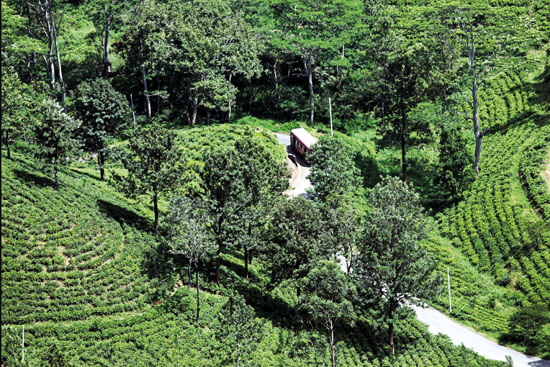Mind the connectivity!
View(s):The rural village of Pelawatta remained largely disconnected from any urban centre, with the nearest town, Mathugama, located approximately 25 km away. Despite numerous unmet needs that could have been addressed through access to a township, villagers faced significant difficulties reaching Mathugama due to the absence of a proper roadway.
Access to Aluthgama—another small town roughly 35 km away—was equally limited. As a result, the people of Pelawatta and its surrounding villages lived in relative isolation, cut off from the lifelines of urban connectivity.

File picture of a road in a tea-growing area. The British constructed roads in tea areas for an economic purpose.
Plea for a road
The villagers of Pelawatta felt a deep and growing need for road access to Mathugama. They turned to the colonial government, petitioning through the Village Mudali, the local administrator. Mudali was ranked above the Arachchi and served under the Government Agent in the region as the bridge between the colonial authorities and the people.
Over the years, and even decades, villagers submitted written requests through the Mudali, urging the construction of a road linking Pelawatta to Mathugama. Despite their persistence, the colonial administration showed little interest in meeting their demand.
By then, the government had already laid the foundation for the island’s main road network, beginning with the Colombo–Kandy highway in the early 1800s. The first highway was built initially to transport coffee, and later tea, to the commercial capital, Colombo.
By the early 1900s, these roads were upgraded with tarmac, made by mixing tar and crushed stone. A privately operated public bus system had emerged by 1907. Meanwhile, the railway network—launched with the Colombo–Kandy line in 1864—was also well established.
Yet amid these sweeping improvements in physical connectivity, Pelawatta remained excluded. The village stayed isolated—until 1923, when the discovery of graphite in its soil flipped the story on its head.
Graphite revolution
 During colonial times, Sri Lanka was internationally recognised as a major producer of graphite and the supplier of the world’s purest form of the mineral. At its peak, the country fulfilled over 30 per cent of global graphite demand and generated more than 20 per cent of its foreign exchange earnings through this valuable resource. The largest importers included the UK, the US and Germany. Today, however, Sri Lanka’s contribution to global graphite exports has declined to less than one per cent.
During colonial times, Sri Lanka was internationally recognised as a major producer of graphite and the supplier of the world’s purest form of the mineral. At its peak, the country fulfilled over 30 per cent of global graphite demand and generated more than 20 per cent of its foreign exchange earnings through this valuable resource. The largest importers included the UK, the US and Germany. Today, however, Sri Lanka’s contribution to global graphite exports has declined to less than one per cent.
Against this historical backdrop, the discovery of graphite deposits in Pelawatta sparked enormous interest from a commercial standpoint. For local villagers, it marked a turning point—not only economically, but socially. Their long-standing dream of road access to Mathugama was finally realised.
In response to the newfound industrial potential, the colonial government constructed roads linking Pelawatta to both Mathugama and Aluthgama. These routes were established primarily to support the graphite trade, improving market access and streamlining transport.
Yet the impact extended far beyond commerce. The new roads created positive ripple effects throughout the region—connecting Pelawatta’s residents with neighbouring towns, expanding their mobility, and opening doors to income opportunities and employment. Once cut off from development, Pelawatta and its surrounding villages began to flourish.
Encroaching wildlife
At the time of independence from British rule, Sri Lanka had a population of just seven million. In the 75 years since, that number has more than tripled. Yet, despite the passage of the Town and Country Planning Ordinance passed in the Parliament in 1947, the country lacked a comprehensive national physical plan to guide land use and settlement patterns.
As a result, population growth did not remain concentrated around urban centres. Instead, people expanded into remote rural areas—often encroaching on wildlife habitats. This led to escalating environmental degradation and growing conflicts with wildlife, including wild elephants.
Politics further fuelled this trend. Successive governments and politicians facilitated forest clearance and land distribution, parcelling out plots to the poor in exchange for their vote at the elections. Housing projects and welfare schemes were launched using taxpayer money, government borrowings, and foreign aid—all aimed at sustaining rural settlement.
Wildlife threat
Yet life in these remote regions remained harsh. Livelihoods were meagre, and poverty persisted. To this day, over 80 per cent of Sri Lanka’s impoverished population resides in the rural sector, constituting an everlasting poverty alleviation problem among marginalised rural communities.
There remains a strong expectation that the government must ensure essential infrastructure—roads, schools, health care, water, electricity, communication, markets and public services—reaching even the most remote villages. But beyond basic development, another urgent plea echoes across these landscapes: the cry for protection against escalating wildlife threats.
Governments past and present have struggled to safeguard villagers’ lives, livelihood and livestock from wild elephants and roaming leopards. Despite numerous initiatives, there has yet to be an effective, lasting solution to the intensifying human–wildlife conflict. And how could there be, when expanding human settlements continue to clash with shrinking natural habitats?
The two episodes
The story of Pelawatta—and many others from colonial Sri Lanka—reveals that the British government was highly selective in public spending, investing only when a clear economic return justified each rupee spent.
For nearly 25 years, the request to construct the Pelawatta–Mathugama road went unanswered, as the government found no compelling economic rationale. Although there is a social development need, from a colonial point of view it must be accompanied by direct economic returns to investment. The colonial government stance changed abruptly with the discovery of graphite mines in Pelawatta—a commercially lucrative resource that realigned the government’s priorities.
The pattern was not unique. The first intercity road and railway line in the country, both connecting Colombo and Kandy, were developed primarily to serve the booming plantation economy in the central highlands. Historical records suggest that Sri Lanka’s early development achievements, including its expansive welfare system, were underpinned by the profitability of the plantation sector.
Notably, even the Colombo–Kandy railway was not financed through the colonial government’s budget. The Ceylon Railway Company, established by the British colonial government, shouldered most of the investment by issuing bonds in London’s capital market. The British government contributed only 10 per cent of the initial capital cost. Repayment of the loan was covered by railway-generated income and a newly introduced export tax on tea transported by the railway—ensuring minimal strain on the colonial treasury.
Lessons to be learnt
The British colonial administration appeared to follow a set of disciplined economic principles in its governance. Public funds were deployed sparingly, and rarely on unproductive ventures. Even when projects yielded some social benefit, it was clear that the government prioritised direct and measurable economic returns above all.
This approach is well illustrated by the development of Sri Lanka’s railway network. Though the Ceylon Railway Company was established by the colonial government, its operations were driven by commercial viability, not government subsidies. The Colombo–Kandy railway line paid for itself—its revenue not only repaid the company’s loan capital but also funded the expansion of railway infrastructure across the island, all without drawing from the government budget.
The government played a distinctly limited role, opting to facilitate rather than directly engage in business. This restrained involvement highlights an enduring lesson: the power of market connectivity as a catalyst for prosperity—whether for a community or an entire nation.
Without connectivity—physical or regulatory—progress stalls. Communities that remain isolated, economically or geographically, are often left behind. True development lies not just in constructing infrastructure, but in breaking the barriers that prevent people, goods, and ideas from moving freely.
(The writer is Emeritus Professor at the University of Colombo and Executive Director of the Centre for Poverty Analysis (CEPA) and can be reached at sirimal@econ.cmb.ac.lk and follow on Twitter @SirimalAshoka).
Hitad.lk has you covered with quality used or brand new cars for sale that are budget friendly yet reliable! Now is the time to sell your old ride for something more attractive to today's modern automotive market demands. Browse through our selection of affordable options now on Hitad.lk before deciding on what will work best for you!


